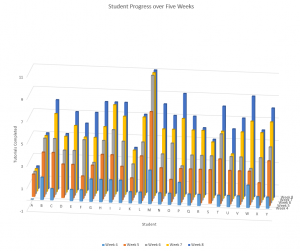Data from a middle school self-paced blended learning class reinforces the concept that variation from one student to the next is significant
 “If you design something for the average …person, wouldn’t it fit most people?”
“If you design something for the average …person, wouldn’t it fit most people?”
Todd Rose – The Myth of Average: from TEDx
This seems like a natural conclusion to draw, but research has shown this is incorrect. As Todd points out in his talk, research was undertaken 60 years ago by the U.S. Air Force into the average size of fighter pilots. The goal was to design a jet cockpit that would be the best fit for pilots.
After collecting data on a range of physical body measurements, a profile of the “average” pilot was made. They then searched their data to determine the number of pilots who would fit this “average” profile. The expectation was that there would be quite a few. The reality was different; not one pilot fit the average profile. There was no such thing as an average pilot.
The concept of the average student is probably equally misleading.
Data from a middle school self-paced blended learning class reinforces the concept that variation from one student to the next is significant. This data is not a “one off” and has been reproduced many times, in many other classes.
(Next page: Self-paced blended learning assessments)
Students were tracked in a technology course where all learning materials were available via an Online Learning Environment (OLE) and every student could access the material on his/her own computer. The learning materials were in the form of video tutorials and equivalent Acrobat files (the electronic equivalent of paper) and other support materials.
This supported different learning styles. As it was a blended learning course, students had the support of a teacher, and peer teaching was also encouraged. Thus, it contained the best of both worlds – technology and a real world teacher/classroom environment.
The analysis began in Week 4 of the course, with the students actually starting the topic in Week 3. Thus, almost all students had begun the tutorials. The analysis continued for five weeks, and there were 11 tutorials in the course. Students had to complete an activity to reinforce their knowledge and ensure their understanding of the material at the completion of each tutorial. Once completed successfully, the student could progress to the next tutorial.
Thus, students could not just skim through the tutorials; skills and deep knowledge had to be developed.
Student progress over five weeks
It was immediately obvious that there was a significant variation in student progress. This variation increased markedly over the following weeks, as can readily be seen from the graph. Students soon demonstrated their individuality, by learning at their own pace. Some completed the learning rapidly (Student M), some were slower (Student Q) and one student was absent due to illness (Student A). Interestingly, because the course was available online, Student A was able to easily and quickly catch up once recovered. This would have been very difficult in a traditional classroom.
In a traditional classroom, lessons are often pitched at the learning pace of the “average” student. In a differentiated traditional classroom, learning materials may be aimed at two or three levels or rates of learning. Is this enough?
Technology has the power to unleash individual student potential. It has the power to allow what is almost impossible in a traditional classroom; students learning at a pace suitable for each individual instead of the pace of the non-existent “average” student.
We need to leverage technology to embrace this possible future as quickly as possible. Our students deserve nothing less.
Peter West is Director of eLearning at Saint Stephen’s College in Australia. He has over 15 years’ experience leading K12 schools in technology enhanced education, particularly blended learning using online learning environments. He can be contacted at pwest@ssc.qld.edu.au.
- The traditional classroom works so why change it? - February 23, 2017
- Are outdated computers reverting students to a prehistoric era? - November 17, 2016
- Blended learning and the paradox of the experienced teacher - September 30, 2014


